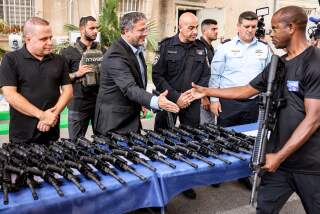Negev Is Training Ground for Skilled Israeli Armored Corps : Desert warfare: Lessons and advice for Americans: Master the machines, drink lots of water, adapt to the heat.
- Share via
SHIZAFON, Israel — The main battle tanks rumbled forward belching fire and throwing up plumes of fine, buff-colored dust.
As they moved across the hot sand of the Negev desert they fired at old tank hulls, at simulated enemy bunkers and at foxholes with cutouts of infantrymen armed with anti-tank missiles.
The scene played out in Israel in training Wednesday could soon be repeated by American armored forces, with real targets, in Saudi Arabia.
This is the Israeli army’s School of Armor. Its graduates have fought in five desert wars, and many military experts believe that they are second to none when it comes to handling tanks in the desert.
The school motto, translated loosely from the Hebrew, is: “It is the man inside who makes the tank.”
The Israeli armored corps has what it believes is the finest tank in the world, the locally produced Merkava (Chariot), and the emphasis in training crews is placed on making them masters of their equipment.
“Our training is based on quality,” a senior officer said during a break in the roar of tank engines and gunfire. “We have to be very careful of our human resources, yet we have to always have the initiative. We believe battles are decided by men more than machines.”
What do Israeli tankers think is the most difficult problem in adjusting to desert operations? And what could American tankers learn from them?
“The main thing is the heat,” a young lieutenant who commands a platoon of tanks said. “Today it’s not so bad, because there’s a slight wind. Usually it feels hotter. And the dust makes your eyes smart, and then it’s difficult to see. You aim and pray.
“The only way to beat the heat is by drinking a lot of water. You’ve got to drink a liter (slightly over a quart) every hour or two. Otherwise you’ll get dehydrated, sick, dizzy, feverish. If you don’t feel well, you don’t fight well.”
A sergeant-instructor put in: “It is very important to receive all your training in the desert, as we do here. It isn’t easy to adjust to these conditions, so you must grow accustomed to them over the months.
“It may be difficult for the Americans, who we believe to be very capable, to get used to the desert if they have not been trained there.”
U.S. armored forces conduct maneuvers at the National Training Center at Ft. Irwin in California’s Mojave Desert, but their school is situated in the gentler terrain of Ft. Knox, Ky.
Similarly, the British armor school is in the rolling, green south of England. And U.S. and British armor tactics and strategy are aimed largely at fighting large-scale tank battles against Soviet-led forces on the plains of northern Europe.
The Israelis have fought their wars in the Sinai desert, in the hills of the West Bank and the Golan Heights and, most recently, in the rocky, sandy terrain of Lebanon.
Israeli tankers have had to learn the hard way. After their lightning victory against Egypt, Jordan and Syria in the Six-Day War of 1967, the armored corps was king. Tanks were believed to be capable of operating alone, without infantry or artillery.
But in the Yom Kippur War of 1973, stubborn Egyptian infantrymen using Soviet-made Sagger anti-tank missiles knocked out scores of Israeli tanks, causing consternation in the armored corps. Infantry and artillery, it was concluded, are necessary.
Israel then revised its tactics, and when it invaded Lebanon in 1982 the tank force again performed superbly, despite determined opposition by Syrian forces.
“We believe now that a tank crew fights better if it is reasonably comfortable,” an Israeli officer said Wednesday. “This is a doctrine the Soviets, with their cramped tanks, have never subscribed to.”
With this in mind, Israeli designers under Gen. Israel (Talik) Tal built the 65-ton Merkava as a user-friendly vehicle, one of the world’s most comfortable tanks for its four crewmen. In addition, it has a very low profile, making it a difficult target.
In a break with tradition, the Merkava’s diesel engine was placed forward of the crew compartment, providing additional protection from head-on enemy fire. The Merkava is equipped with the latest reactive armor, which tends to deflect cannon fire, a new 120-millimeter gun and fire-control gear that is state-of-the-art yet simple to operate.
It has a cooling system that allows the crew to wear protective uniforms, flak jackets and helmets.
“This tank is absolutely the best,” a crewman said, patting the tread of his Merkava. “We’ve fought Soviet-made tanks in Arab armies, and there’s no comparison.”
In addition to the Merkava, the Israelis also have some U.S.-made M-60 Pattons and older British Centurions.
Tankers trained here are taught to move quickly over a ridge, to fire rapidly at the target and then reverse to take cover. A good crew is expected to destroy its target with no more than three rounds.
The Israelis believe that the best Arab armored forces are still inferior to those of Israel and the United States. They say that studies of Iraqi tank tactics in the recent war with Iran show the Iraqis to be deficient.
“I think you can say to the Americans,” a young instructor told a reporter, “that the latest Soviet tanks are good but not good enough.”
More to Read
Sign up for Essential California
The most important California stories and recommendations in your inbox every morning.
You may occasionally receive promotional content from the Los Angeles Times.













